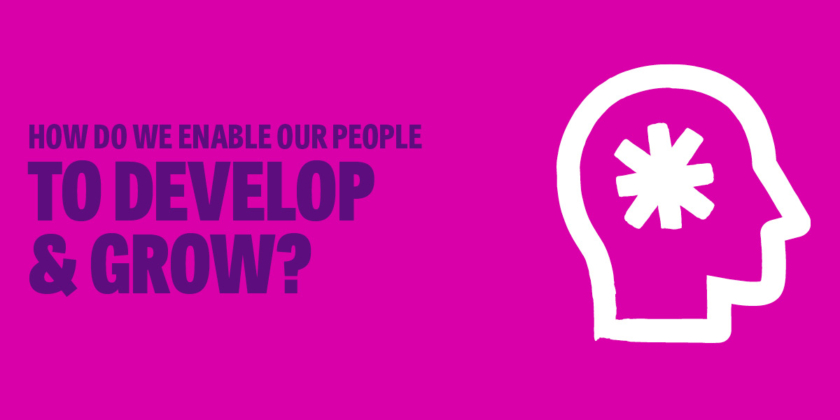Using L&D to enable people to grow, develop and unlock their potential
Businesses everywhere find it hard to attract, retain, and grow great people, as employees require specialist skills or training and are regularly courted with offers of high salaries, promotions, or other perks.
Adding to this the fact that 40% of workers are leaving their current jobs as they feel career development opportunities are limited, it would seem that making sure employees are motivated, energised, and feel they can learn and grow is no longer a nice-to-have.
It’s no secret that the science industry is a competitive one when it comes to recruitment, and it’s an absolute priority for companies operating in this space to attract and retain top people.
Our medical research charity client was no different: they wanted to ensure they retained their talented staff in a tight labour market and called Let’s Talk Talent (LTT) in to help them do that.
Here’s how we helped, and how you can do the same at your organisation, regardless of the industry you’re in.
Using L&D as a retention tool
There are several reasons why it’s hard to attract, keep, and grow great people in the science industry. Overall, the market tends to hold a fairly traditional and linear view of career progression, with staff mostly looking to move up in the grade system or to hold a senior position, rather than opting for alternative career progression opportunities.
In short, the industry often places more emphasis on getting a promotion rather than exploring other, equally rewarding development options. However, the number of promotions available is limited, and a large number of candidates are often left unsure of what to do or where to turn to for progression, which can lead to frustration.
Since candidates take a long time to recruit, onboard, and fully train – impacting performance and budgets should they decide to move on – it was important for our client to act fast.
Our challenge was clear: we were going to have to find new ways to enable people’s growth and development and unlock their potential. In short, we would have to show them the art of the possible.
Getting started: establishing the learning and development deal
Before getting stuck in, we wanted to lay the right foundations. This meant defining what learning and development means for the company: something we called the L&D philosophy.
In this document, we clearly highlighted the deal:
- The resources to be provided by the organisation to help staff develop;
- What was expected of employees in return.
It’s worth mentioning that, at Let’s talk Talent, we believe in the 70/20/10 ratio for L&D. This model puts most of the accountability for their own development squarely on staff’s shoulders, with the right amount of support from both managers and the organisation as a whole.
As such, we wanted the L&D philosophy to highlight that staff had the power to take charge of their own development, and that the organisation was going to be right there to support and guide them along the way.
What to include in an L&D communication plan
Next, we wanted to put this theory into practice. Now that we’d established that staff could (and should) be accountable for their own development, this important message had to be communicated to the entire company’s talent pool.
We spent time devising a communications plan that would support the rollout of the new initiative. The plan contained all the information individuals may require to feel truly empowered to take action, such as:
- A commitment from the company to give its people the time and space to learn new skills or deepen their expertise;
- The various learning options available to them, including on-the-job training, mentoring, shadowing, networking, and formal training courses like webinars and workshops;
- The amount of time each employee was expected to commit to self-development;
- Some clear next steps to follow to get started on their learning and development journey.
Using real-life learning and development examples
Let’s Talk Talent also knows it can be hard for employees to determine which way to go to develop their career. That’s why we believe in showing (rather than telling) people the way. And let’s face it, at Let’s Talk Talent, we just don’t do ‘beige’.
It was obvious that we were not going to create standard L&D PowerPoint presentations full of bullet points and lists: we needed to find ways to bring the development deal to life.
We sourced real-life stories from current employees, showcasing the world of possibilities to their peers. Examples of successful development stories from all over the business were promoted, illustrating the many options available for anyone hoping to move their careers forward as part of the organisation’s community.
Setting managers up for success
Lastly, we wanted to utilise the business’s best assets: its managers. We needed to ensure they had the capabilities to hold effective career conversations with their staff, and to better support their team members throughout their development journey.
A training programme was designed specifically for line managers, with custom courses aimed at helping them hone their active listening skills, leadership and decision-making skills amongst others.
Final thoughts: resources not courses
Learning and development plays a key part in both staff attraction and retention. And in the competitive science market, its importance cannot be understated.
There is a clear need to stand out from the crowd, as having the right people in place will have a huge impact on organisational performance. But as we’ve discovered, helping staff with their career progression isn’t just about throwing a bunch of free courses at them.
“It’s about resources, not courses,” says Jo Taylor, MD at LTT.
It’s important for staff to know they are the ones with the power to decide how to develop their career, but it is equally important to enable them to take concrete action once they’ve set their own objectives.
This approach to learning and development did both, which is why it was such a success.
If, like our client, you’d like to provide your talented people with the tools they need to feel motivated, energised, and empowered to start their development journey, don’t hesitate to book a call with us. Alternatively, visit our Learning and Development Strategy services page or download our free L&D Strategy whitepaper.

